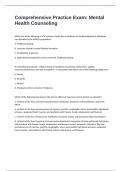Comprehensive Practice Exam: Mental
Health Counseling
Which one of the following is NOT a primary factor that contributes to the development of substance
use disorders in the LGBTQ+ population?
A. Childhood teasing
B. Stressors related to sexual identity formation
C. Socialization at gay bars
D. Internalized homophobia correct answersA. Childhood teasing
A motivational syndrome—which consists of symptoms of passivity, aimlessness, apathy,
uncommunicativeness, and lack of ambition—is associated with which one of the following substances?
a. Heroin
b. Inhalants
c. Alcohol
d. Marijuana correct answersd. Marijuana
Which of the following best depicts the chronic effects of long-term severe alcohol use disorder?
a. cirrhosis of the liver, permanent psychomotor retardation, blackouts, malnourishment, and heart
attack
b. cirrhosis of the liver, permanent loss of memory, gastritis, esophagitis, ulcers, pancreatitis, high blood
pressure, weakened heart muscles, and problems with friends, family, employment and finances
c. cirrhosis of the liver, memory loss, flashbacks, increased anxiety and permanent depersonalization
d. cirrhosis of the liver, long-term immune system depression, supression of male and female hormones,
and problems with friends, family, employment and finances correct answersb. cirrhosis of the liver,
permanent loss of memory, gastritis, esophagitis, ulcers, pancreatitis, high blood pressure, weakened
heart muscles, and problems with friends, family, employment, and finances
,Which ethnic group in the United States experiences an earlier onset of substance use and substance use
disorders, has a greater likelihood of going to prison for their use, and has higher rates of negative health
effects, such as cirrhosis of the liver and esophageal cancer, than other ethnic groups?
a. Native Americans
b. Hispanic Americans
c. Asian Americans
d. African Americans correct answersd. African Americans
Which of the following substances is typically associated with the following withdrawal symptoms:
increased anger, hostility, aggression, loss of social cooperation, and decreased ability to handle stress?
a. marijuana
b. nicotine
c. cocaine
d. alcohol correct answersb. nicotine
The stages of the Gorski Model of relapse prevention are:
a. emotional, physical, and mental
b. use, treatment, relapse, early recovery, middle recovery, and late recovery
c. precontemplation, contemplation, preparation, action, maintenance and relapse
d. transition, stabilization, early recovery, middle recovery, late recovery and maintenance correct
answersd. transition, stabilization, early recovery, middle recovery, late recovery and maintenance
David Hawkins and colleagues researched the typical risk and protective factors that occur in the
community, family, school and among individuals. Which one of thee categories have risk factors of
"early and persistent antisocial behavior, academic failure beginning in elementary school, and lack of
commitment to school"?\
a. the family risk category
b. the school risk category
c. the community risk category
d. the individual or peer risk category correct answersb. the school risk category
,Which one of the following mental health disorders is least likely to be seen in conjunction with a
substance use disorder?
a. anxiety
b. Tourette's Syndrome
c. hypochondriasis
d. depression correct answersc. hypochondriasis
The primary modality for treating substance use disorders is:
a. day treatment
b. 12 step programs
c. residential care offered in free standing treatment centers operated by hospitals or behavior health
agencies
d. community care correct answersc. residential care offered in free standing treatment centers operated
by hospitals or behavior health agencies
Jamal has regularly used his drug of choice for over five years, which has the acute effects of rise in heart
rate and blood pressure, a higher body temperature than normal, dizziness, dilated pupils, sensory
distortions, dreaminess, depersonalization, altered mood, and impaired concentration. What substance
is Jamal most likely using?
a. LSD
b. inhalants
c. heroin
d. PCP correct answersa. LSD
According to the Public Health model of prevention, primary prevention is targeted at those:
a. Who meet criteria for a substance use disorder
b. Communities that have significant problems with substance use disorders
c. Who are just beginning to use substances, but who are already showing signs of difficulty
d. With little to no experience with alcohol, tobacco, or other drugs correct answersd. with little to no
experience with alcohol, tobacco, or other drugs
, What act created prohibition in the United States, banning the production, transportation, import,
export, sale, and consumption of alcohol?
a. The Alcohol and Prohibition Act
b. The Volstead Act
c. The Harrison Act
d. The Rockefeller Alcohol Act correct answersb. The Volstead Act
Approximately what percentage of individuals who administer mood altering substances intravenously
are HIV positive?
a. 70-80 percent
b. 5-15 percent
c. 30-40 percent
d. 40-50 percent correct answersc. 30-40 percent
What percentage of incarcerated juveniles were under the influence of a substance when they
committed their crimes?
a. 10 percent
b. 25 percent
c. 50 percent
d. 80 percent correct answersd. 80 percent
Sam uses a substance that he believes helps him in his job as a firefighter. Many of Sam's friends and
coworkers also take this substance, so he believes that this substance is harmless. What Sam does not
know is that this substance can cause atrophy of the testicles, impaired production of sperm, infertility,
early baldness, acne, enlargement of the breasts, coronary artery disease, jaundice and liver tumors.
What substance is Sam most likely using?
a. benzodiazepines
b. opiods
c. amphetamines
d. anabolic steroids correct answersd. anabolic steroids





